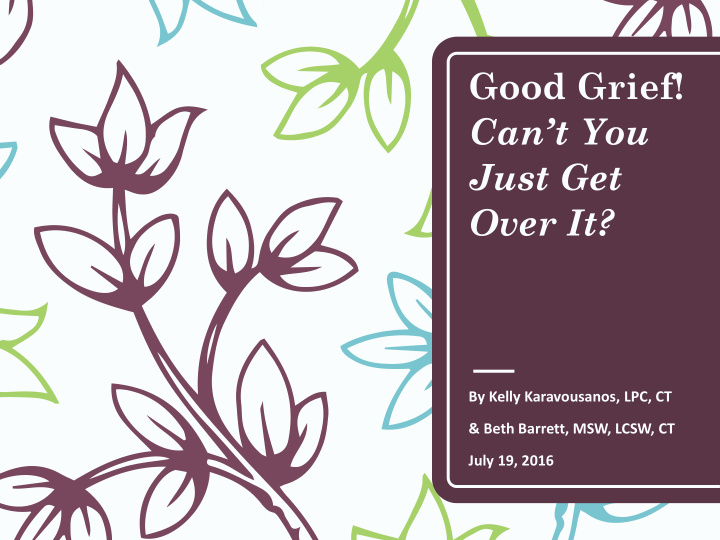



Good Grief! Can’t You Just Get Over It? By Kelly Karavousanos, LPC, CT & Beth Barrett, MSW, LCSW, CT July 19, 2016
Good Grief! Can’t You Just Get Over It? Participants will: Gain an understanding of the essentials of grief as a continuum from diagnosis through after death. Explore the three dimensions of grief. Identify best practices for supporting those who are grieving.
What is Grief?
Grief is……. . – The body’s natural reaction to change and loss – Cumulative – Different for everyone – Different reactions and coping skills – Different time frames – Differences within a family – Painful and lonely
Grief is…. . (cont’d) – NOT just when a loved one dies – NOT on a timeframe or schedule – NOT linear – NOT the “5 Stages of Grief!”
Grief throughout disease The Process of a Patient’s Illness – Symptoms develop; changes may occur – Tests, doctor appointments, specialists – Diagnosis given – May be expected outcome OR may come as a surprise – Adjustment to diagnosis and prognosis – Continued progression of disease – Continued losses – Nearing end of life – Death of patient
Dimensions of Grief ~ Dr. Alan Wolfelt, PhD 1) EVASION from the New Reality 2) ENCOUNTER with the New Reality 3) RECONCILIATION with the New Reality
Dimensions of Grief : Evasion from the New Reality Mourning Time Course Primary Role of Primary Needs of Characteristics Helper Mourner ~ Weeks ~ Shock ~ Supportive ~ Self Protection ~ Denial Presence ~ Potentially ~ Numbness Months ~ Psychological ~ Disbelief ~ Assist with Shock Absorber Practical Matters (Variable)
Dimensions of Grief : Encounter from the New Reality Mourning Primary Needs of Characteristics Mourner Primary Role of Helper ~ Confusion Time Course ~ Anxiety ~ To experience & ~ Encourage expression ~ Physiological Changes express reality of the ~ Many months of thoughts & feelings death ~ Explosive Emotions ~ Loss, Emptiness (Variable) ~Stabilizing, comforting ~ To tolerate emotional ~ Guilt presence suffering ~ Sadness, Remorse
Dimensions of Grief : Reconciliation from the New Reality Mourning Characteristics Primary Needs of Mourner ~ Organize & plan toward ~ Convert relationship with Primary Role of Helper Time Course future deceased to one of memory ~ Supportive ~ 24-36 months ~ New, healthy relationships ~ Develop new self-identity encouragement (Variable) ~ Openness to more change ~ Relate loss to context of ~ Understanding, available in one’s life meaning presence
How do we help those who are grieving? Best Practices
Best Practices for working with the grieving “Companioning”
Best Practices for working with the grieving (cont’d) Active Listening – & Being Present
Best Practices for working with the grieving (cont’d) EDUCATION about grief — ” Normalizing ” – Be cautious with this — don’t dismiss feelings or misinterpret a serious situation
Best Practices for working with the grieving Not being judgmental – Just because someone grieves differently than you do or think they should, does not mean they are grieving inappropriately
Best Practices for working with the grieving (cont’d) Stories • Ask about their loved one and let them share
Best Practices for working with the grieving (cont’d) Roller Coaster of Grief • Within oneself • Family Dynamic
Best Practices for working with the grieving (cont’d) “Ocean” analogy – Floating vs. resisting
Best Practices for working with the grieving (cont’d) – Embracing new reality – Help them grieve cummulative losses – Helping client acknowledge the person – Recognizing all that has s/he was before, but is changed has changed now forever changed – Education of these through grief process concepts and issues – Trying to get back to the – Baby steps toward way things were----but building or identifying accepting that loved one new skills is dead and client is a very different person now.
Good Grief! Can’t You Just Get Over It? NO, YOU CAN’T….. BECAUSE IT IS A JOURNEY, NOT A DESTINATION. BUT YOU CAN: – LEARN FROM GRIEF – GROW FROM GRIEF – LIVE WITH GRIEF IN A POSITIVE WAY
Recommend
More recommend